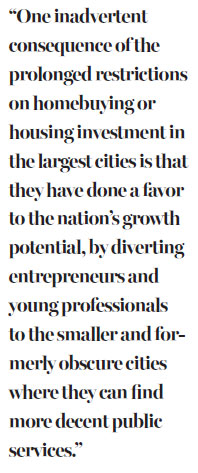Every bubble has a silver lining
Updated: 2016-10-07 07:48
By Ed Zhang(China Daily Europe)
|
|||||||||
Overheating property market could provide a welcome boost for nation's smaller cities
One interesting thing about the National Day (Oct 1) holiday week was that the economy didn't have a holiday at all.
Again, the biggest stir was caused by the real estate market, something so important for every modern economy but apparently still to be tamed, to work as expected by government officials.
Of course, millions of people traveled during the so-called Golden Week for tourism. But when they return home, more will discover that they have been disqualified from buying new homes.

Restrictions on home ownership were announced in more cities - a practice originally adopted by the first-tier cities of Beijing, Shanghai, Shenzhen and Guangzhou, and now including Tianjin, Suzhou, Xiamen, Hangzhou, Nanjing, Chengdu, Zhengzhou, Wuhan, Kunshan (part of Suzhou), Wuxi, Jinan and Hefei.
The most common restrictions are to raise the required down payment, to 40 percent at least, and to require from the buyer proof of local residence and tax contribution, for at least one year on a continuous basis.
Local governments' restrictive policies may spread more widely to cover all cities with a moderate level of economic growth and decent public services in China's coastal and near-coast provinces.
A list of housing prices in 100 cities shows that in 24 of them housing prices already average above 10,000 yuan ($1,500; 1,343 euros; 1,180) per square meter, while 32 cities averaged below 6,000 yuan per sq m. On a month-on-month basis, only 18 cities saw their prices fall in September. Again, some people are alarmed that an asset bubble is being built in China, something very bad that may lead to a general crisis on the scale of the housing market-induced troubles in Japan and in the United States, if not even worse.
Really? A real estate bubble is usually built on three conditions. One, excessive credit, or a level of credit that goes beyond homebuyers' ability to pay it back. China's pool of private savings is an indicator of its society's overall ability to handle so much credit.
Second, a bubble happens in a market when it is not sustained by the potential demand from a large chunk of the population. China's urbanization ratio (urban residents in proportion of the total population) is low, with many rural people working in the cities still to move their families to where their jobs are.

The danger of a bubble can be kept under control if new homes are only sold to people holding decent, or relatively secure, jobs.
Third, a bubble becomes ugly when it is geographically focused, for instance, on only the few first-tier cities. If the trend is being led by around 30 cities (those showing above 2 percent month-on-month increases in their average housing prices in September), the risk can be more diffused.
In some of the 30 cities, homebuyers don't get their value. But there are smaller cities, such as Kunshan, Dongguan, Jiangyin and Zhangjiagang, with relatively decent business and regulatory environments. They are likely to be faster builders of industries and services in the nation's next cycle.
It should be pointed out, in addition, that the cities mentioned above are more competitive in the global market and have very few state-owned enterprises.
By contrast, some of the cities dominated by SOEs, such as Shenyang, Changchun, Handan and Anshan, are among the ones showing a net fall in housing prices in September.
One inadvertent consequence of the prolonged restrictions on homebuying or housing investment in the largest cities is that they have done a favor to the nation's growth potential, by diverting entrepreneurs and young professionals to the smaller and formerly obscure cities where they can find more decent public services.
China's next cycle of development may well be led by a dozen smaller cities (including the above mentioned) competing against the large cities struggling with increasing difficulties in their public services.
In the long run, only these cities will provide a balance (of a genuinely market type).
People should remember that China's development, ever since the 1980s, has featured a new city-building effort in every stage - Shenzhen and a bunch of special economic zones in the 1990s, followed by Hainan province, by Pudong New Area in Shanghai in the 2000s, and then by Binhai New Area in Tianjin.
For the past decade or so, no initiative has been taken by the central government, while the nation's population base still allows for a new round of city-building.
In fact, the absence of an obviously centralized initiative will contribute to a more natural, and likely more intense, process of competition among cities building their futures.
It's only a pity that most such cities are concentrated in either the Yangtze River Delta or the Pearl River Delta.
The author is an editor-at-large of China Daily. Contact the writer at edzhang@chinadaily.com.cn
(China Daily European Weekly 10/07/2016 page13)
Today's Top News
Theresa May shifts her party toward the center
Security Council agrees on Guterres as next UN chief
Rudd says immigration speech not racist
West may be best for nation's teenagers
Trio wins Nobel chemistry prize for 'nano machines'
IMF sees Brexit damage to British growth
Three scientists share 2016 Nobel Prize in Physics
BRICS need to find their purpose again: O'Neill
Hot Topics
Lunar probe , China growth forecasts, Emission rules get tougher, China seen through 'colored lens', International board,
Editor's Picks

|

|

|

|

|

|







